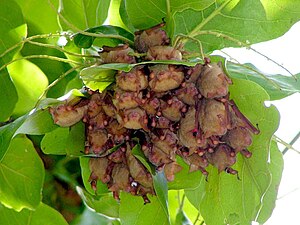Hodgson bat
| Hodgson bat | ||||||||||||
|---|---|---|---|---|---|---|---|---|---|---|---|---|

Hodgson's bat ( Myotis formosus ) |
||||||||||||
| Systematics | ||||||||||||
|
||||||||||||
| Scientific name | ||||||||||||
| Myotis formosus | ||||||||||||
| ( Hodgson , 1835) |
The Hodgson's bat ( Myotis formosus ) is a species of mouse ears ( Myotis ) within the bats (Chiroptera). It is common in several spotty areas over large parts of South Asia to East and Southeast Asia.
features
The Hodgson bat reaches a head-trunk length of 45 to 70 millimeters and a tail length of 43 to 52 millimeters. The forearm has a length of 45 to 50 millimeters, the hind feet measure 10 to 12 millimeters and the ears 16 to 17 millimeters. Accordingly, it is a comparatively large species of the genus. The back fur is brown, the belly side is light red-brown. The arm or flank flight skin (plagiopatagium) as well as the tail flight skin (uropatagium) are for the most part also light red-brown, the skin between the fingers is brown-black. The flight membrane attaches to the tarsus on the basal part of the toes. It is covered with short, light hair in places along the arm and on the body. The ears are narrow and long and slightly egg-shaped, the tragus is also long and narrow and tapering to a point. The skin attaches to the base of the toes.
The back of the skull is relatively flat, the cranium is not significantly protruding. The teeth have some species-specific features, for example the outer upper incisor I3 is smaller than the inner incisor I2 and the first upper premolar P2 is larger than the following P3.
distribution
The Hodgson's bat occurs in several patchy areas across much of South Asia to East and Southeast Asia. In South Asia the distribution area extends from Afghanistan ( Nangarhar ) via India and Bangladesh and Nepal to the south and east of the People's Republic of China as well as to North and South Korea and, in a few records, to the Japanese island of Tsushima . The finds on Tsushima are classified as random visitors, colonies are not known on the island. In India it can be found in Assam , Bihar , Himachal Pradesh , Jammu and Kashmir , Jharkhand , Maharashtra , Meghalaya , Mizoram , Punjab , Sikkim , Uttarakhand and West Bengal . In China it occurs in the south and east and is widespread in parts of Sichuan , Zhejiang , Anhui , Shanghai , Hubei , Shaanxi , Jiangsu , Fujian , Guangxi , Guizhou , and it occurs on the island of Taiwan . In Southeast Asia, the species is found in Laos and on several islands in the Philippines and Indonesia . In Indonesia it can be found in Bali , Java , Sulawesi and Sumatra , in the Philippines on Palawan , Negros , Sibuyan and Luzon .
Way of life
The Hodgson bat lives in wooded areas in the lowlands as well as in low mountain locations up to 3000 meters. It prefers primary forest stands , but is also found in secondary forest regions . The species uses the leaves of trees and bushes as well as the treetops as a resting place and spends the day here in groups, it can also be found on and in houses and in caves. Like other bats, it is nocturnal and feeds on insects. In winter it retreats in caves to hibernate.
In South Asia it is described as a regularly occurring but rare species. At the sleeping places it usually gathers to a few individuals, in caves the groups can contain 40 to 50 individuals.
Systematics
The Hodgson's bat is assigned to the mouse ears (genus Myotis ) as an independent species , to which more than 100 species belong. The first scientific description comes from the British naturalist Brian Houghton Hodgson from 1835, who described it under the name Vespertilio formosa using specimens from Nepal. It is possible that several closely related species have to be distinguished within the Hodgson bat and that it is not a single species but a species complex.
Several subspecies are distinguished within the species, for example the subspecies Myotis formosus rufoniger lives in China and in Taiwan it occurs together with the endemic Myotis formosus watasei .
Hazard and protection
The species is classified by the International Union for Conservation of Nature and Natural Resources (IUCN) as not endangered ("least concern"). This assignment is justified by the very large distribution area as well as the large stocks and frequent occurrence. There are no known threats to the species population.
supporting documents
- ↑ a b c d e f Don E. Wilson Hodgon's Myotis. In: Andrew T. Smith , Yan Xie: A Guide to the Mammals of China. Princeton University Press, 2008; P. 376, ISBN 978-0-691-09984-2 .
- ↑ a b c d e f g h i Myotis formosus in the Red List of Threatened Species of the IUCN 2016.2. Posted by: C. Francis, P. Bates, G. Csorba, S. Molur, C. Srinivasulu, 2008. Retrieved November 22, 2016.
- ^ A b Don E. Wilson & DeeAnn M. Reeder (eds.): Myotis formosus in Mammal Species of the World. A Taxonomic and Geographic Reference (3rd ed), 2005
literature
- Don E. Wilson Hodgon's Myotis. In: Andrew T. Smith , Yan Xie: A Guide to the Mammals of China. Princeton University Press, 2008; P. 376, ISBN 978-0-691-09984-2 .
Web links
- Myotis formosus inthe IUCN Red List of Threatened Species 2016.2. Posted by: C. Francis, P. Bates, G. Csorba, S. Molur, C. Srinivasulu, 2008. Retrieved November 22, 2016.

